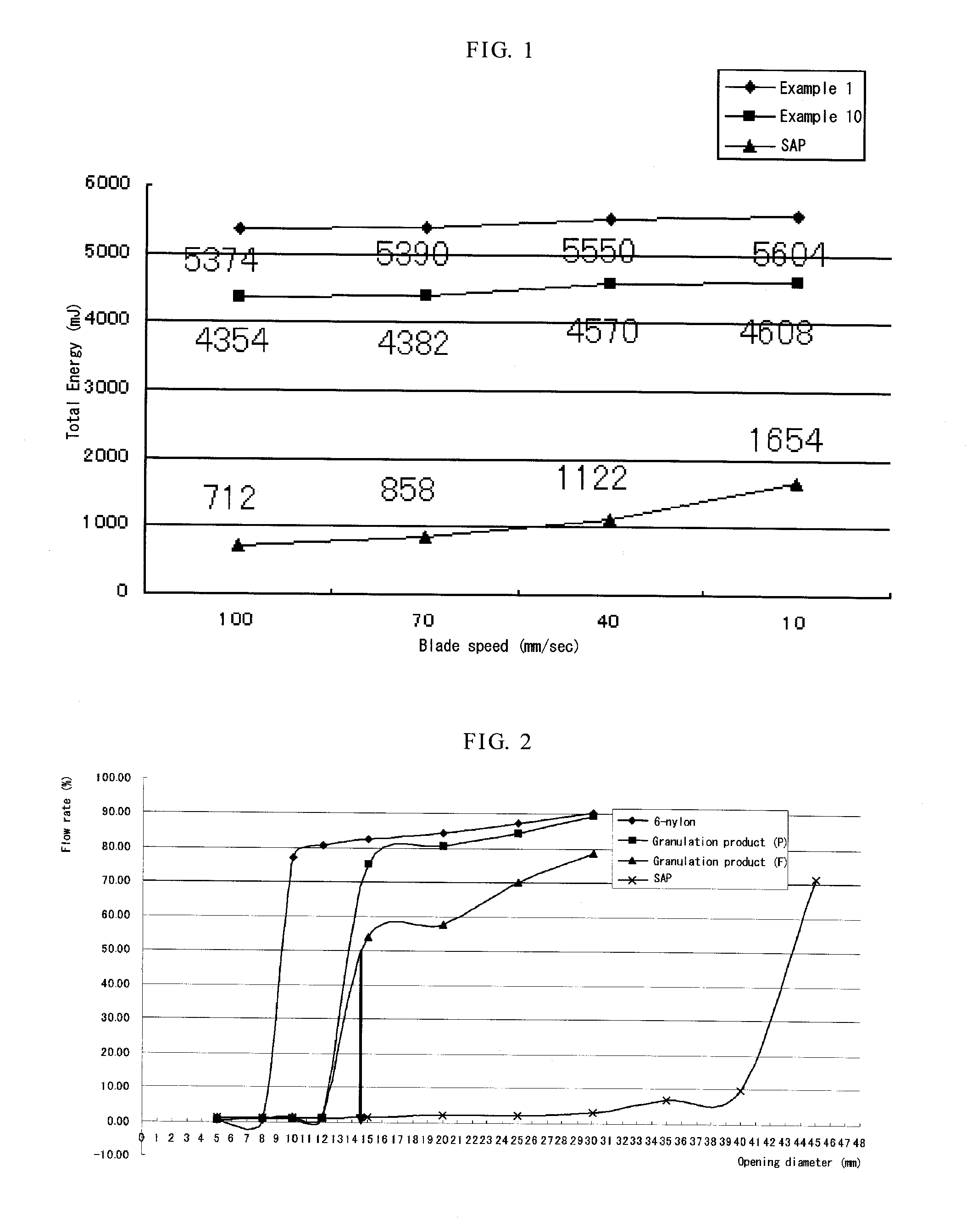Granulated colorant and related art
a colorant and granule technology, applied in the direction of thiazine dyes, dyeing process, organic chemistry, etc., can solve the problems of deterioration of work environment, difficult uniform dispersal of colorant (particularly black pigment) in resin, and difficulty in ensuring the uniform dispersibility of colorant in resin, etc., to achieve excellent mechanical properties, excellent heat resistance, and excellent sliding quality and dimensional accuracy
- Summary
- Abstract
- Description
- Claims
- Application Information
AI Technical Summary
Benefits of technology
Problems solved by technology
Method used
Image
Examples
example 1
(1) Production of Granulated Colorant (Nigrosine Dye: Water=100:35)
[0082]After 2000 g of Nigrosine Base SAP (name of a product manufactured by Orient Chemical Industries, Ltd.; a nigrosine dye as C.I. Solvent Black 7, having a specific surface area of 3.50 m2 / g, an average particle diameter of 7 μm, an Fe content of 6000 ppm, an aniline content of 1.50% by weight, a nitrobenzene content of 0.1% by weight, and a product pH of 5.1) and 700 g of water were blended in a kneader for 3 minutes, the blend was removed.
[0083]This blend was subjected to extrusion granulation treatment using an extrusion granulating machine (Disc Pelletter F-5 model, a commercial product manufactured by DALTON Corporation) with a selected disc die opening diameter of 3 mm, while adjusting the roller revolution speed (120 rpm) and keeping a constant roller pressure (100 kg / cm2), to yield a wet colorant comprising a cylindrical pellet (granulation product) and partially ungranulated material. This pellet was rem...
example 2
(1) Production of Granulated Colorant (Nigrosine Dye: Water=100:35)
[0086]After 2000 g of Nigrosine Base SAP and 700 g of water were blended in a kneader for 3 minutes, the blend was removed. This blend was subjected to extrusion granulation treatment using an extrusion granulating machine (Disc Pelletter F-5 model) with a selected disc die opening diameter of 2 mm, while adjusting the roller revolution speed and keeping a constant roller pressure, to yield a wet colorant comprising a cylindrical pellet (granulation product) and partially ungranulated material. This pellet was removed and its hardness was determined to be 1.96 N using a hardness meter (KIYA type hardness meter: WPF1600). The bulk density of the granulation product was 0.59 g / ml.
[0087]The wet colorant obtained was dried at 70° C. for 5 hours to yield a colorant containing 80% by weight of a cylindrical pellet. The colorant obtained was sieved to yield a cylindrical pellet of 0.92 mm×9.37 mm (granulated colorant A-2). ...
example 3
(1) Production of Granulated Colorant (Nigrosine Dye: Water=100:47.8)
[0089]After 2000 g of Nigrosine Base SAP and 950 g of water were blended in a kneader for 3 minutes, the blend was removed. This blend was subjected to extrusion granulation treatment using an extrusion granulating machine (Disc Pelletter F-5 model) with a selected disc die opening diameter of 5 mm, while adjusting the roller revolution speed and keeping a constant roller pressure, to yield a wet colorant comprising a cylindrical pellet (granulation product) and partially ungranulated material. This pellet was removed and its hardness was determined to be 6.86 N using a hardness meter (KIYA type hardness meter: WPF1600). The bulk density of the granulation product was 0.60 g / ml.
[0090]The wet colorant obtained was dried at 70° C. for 5 hours to yield a colorant comprising 78% by weight of a cylindrical pellet. The colorant obtained was sieved to yield a cylindrical pellet of ø4.93 mm×15.48 mm (granulated colorant A-...
PUM
| Property | Measurement | Unit |
|---|---|---|
| density | aaaaa | aaaaa |
| diameter | aaaaa | aaaaa |
| particle diameter | aaaaa | aaaaa |
Abstract
Description
Claims
Application Information
 Login to View More
Login to View More - R&D
- Intellectual Property
- Life Sciences
- Materials
- Tech Scout
- Unparalleled Data Quality
- Higher Quality Content
- 60% Fewer Hallucinations
Browse by: Latest US Patents, China's latest patents, Technical Efficacy Thesaurus, Application Domain, Technology Topic, Popular Technical Reports.
© 2025 PatSnap. All rights reserved.Legal|Privacy policy|Modern Slavery Act Transparency Statement|Sitemap|About US| Contact US: help@patsnap.com


